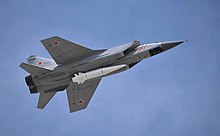Ch-47M2 Kinschal
Ch-47M2 Kinschal ( Russian Х-47М2 Кинжал , " dagger ") is a ballistic air-to-surface missile made in Russia. The overall system is referred to as 14К168 Буревестник Burewestnik ("Petrel") and the guided weapon is designated 14A045 .
development
The idea of ballistic missiles launched from airplanes is not new. For example, the United States and the Soviet Union developed the AGM-48 Skybolt and the Ch-45 Molnija ( Russian Х-45 Молния ) in the 1960s to 1970s . With these missiles speeds of over Mach 12 and firing distances of over 1800 km were reached. It is unclear when the development of the Ch-47 began. The first information about the project was made public in 2010. The Ch-47 was officially presented on March 1, 2018 as part of Vladimir Putin's speech to the Federal Assembly. After another series of tests, the Ch-47 was adopted into the armament of the Russian armed forces in December 2017.
technology
Little is known about the Ch-47 and the published performance parameters are based e.g. T. on estimates. The rocket has a weight of about 4000 kg, is about 7 m long and has a diameter of about 1 m. Eight trapezoidal stabilization and control surfaces are attached to the rear of the rocket . A nuclear warhead or a fragmentation warhead weighing around 500 kg is to be used as the warhead. Western armaments experts believe that the design of the Ch-47 is based on the 9M723 Iskander missile, as the Ch-47 is externally similar to the Iskander. The MiG-31K and Tu-22M3M were presented as carrier aircraft . After being dropped from the aircraft, there is initially a short period of non-propulsion. The solid rocket engine in the rear of the guided missile only ignites at a safe distance from the aircraft . Then the missile rises on a semi-ballistic trajectory to an altitude of 18-20 km. According to Russian information, it should reach a speed of around Mach 10 and be able to perform evasive maneuvers at any time . During the flight through the earth's atmosphere at hypersonic speed , a very high level of frictional heat arises on the rocket surface and makes a heat coating necessary, especially on the rocket tip and the wings. The steering is presumably done with an inertial navigation system and the satellite navigation system GLONASS . There is speculation about the actual range of the Ch-47. While Russian media report a range of over 2000 km, the West assumes a range of 500–1000 km.
See also
Individual evidence
- ↑ Комплекс 14К168 Буревестник, ракета 14А045. In: militaryrussia.ru. Military Russia, accessed June 8, 2020 (in Russian).
- ^ Federation of American Scientists (FAS): Air-Launched-Ballistic Missiles
- ↑ Airwar.ru: X-45 Молния
- ↑ Testpilot.ru Х-45 Молния
- ↑ a b c CSIS.org: Kinzhal
- ^ Rainer Göpfert: Russia's armed forces are testing new hypersonic missiles. MiG-31 reaches for the "dagger" . In: Fliegerrevue . No. 09/2018 . PPV Medien, ISSN 0941-889X , p. 24 ff .
- ↑ a b c Zvezdaweekly.ru: Гиперзвуковой бросок «Кинжала»: конкуренты еще - в «пеленках»
- ↑ Janes.com: New Russian missile likely to be part of the antisatellite system
- ^ Neil Gibson, London and Nicholas Fiorenza: Russia unveils Kinzhal hypersonic missile. In: IHS Jane's Defense Weekly. March 15, 2018, accessed May 14, 2018 .
- ↑ Hypersonic Quartet: Long-range bombers also get Kinshal missiles. In: de.sputniknews.com. State media company Rossija Sevodnja , July 2, 2018, accessed September 4, 2018 .
- ↑ a b Jill Hruby: Russia's New Nuclear Weapon Delivery Systems - An Open-Source Technical Review. (PDF) In: nti.org. NTI - The Nuclear Threat Initiative, November 1, 2019, accessed January 28, 2020 .
- ↑ Theaviationist.com: Russia Test Fires New Kh-47M2 Kinzhal Hypersonic Missile
